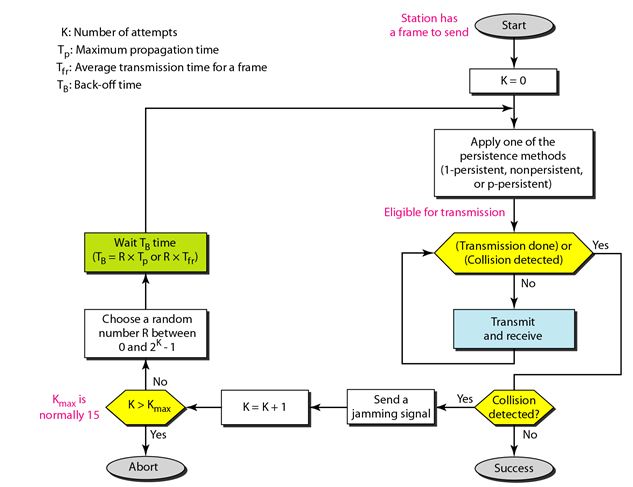Carrier Sense Multiple Access with Collision Detection (CSMA/CD)
The CSMA method does not specify the procedure following a collision. Carrier sense multiple access with collision detection (CSMA/CD) augments the algorithm to handle the collision.
In this method, a station monitors the medium after it sends a frame to see if the transmission was successful. If so, the station is finished. If, however, there is a collision, the frame is sent again.
To better understand CSMA/CD, let us look at the first bits transmitted by the two stations involved in the collision. Although each station continues to send bits in the frame until it detects the collision, we show what happens as the first bits collide. In the following Figure stations A and C are involved in the collision.
• At time t 1, station A has executed its persistence procedure and starts sending the bits of its frame.
• At time t2, station C has not yet sensed the first bit sent by A. Station C executes its persistence procedure and starts sending the bits in its frame, which propagate both to the left and to the right.
• The collision occurs sometime after time t2' Station C detects a collision at time t3 when it receives the first bit of A's frame. Station C immediately (or after a short time, but we assume immediately) aborts transmission.
Random access Protocols
Aloha Protocols
Carrier Sense Multiple Access Protocol
Carrier Sense Multiple Access with Collision Avoidance
• Station A detects collision at time t4 when it receives the first bit of C's frame; it also immediately aborts transmission.
• Looking at the figure, we see that A transmits for the duration t4 – t1. C transmits for the duration t3 - t2. The protocol to work, the length of any frame divided by the bit rate in this protocol must be more than either of these durations. At time t4, the transmission of A’s frame, though incomplete, is aborted. At time t3, the transmission of C's frame, though incomplete, is aborted.
Minimum Frame Size:
For CSMA/CD to work, we need a restriction on the frame size. Before sending the last bit of the frame, the sending station must detect a collision, if any, and abort the transmission.
This is so because the station, once the entire frame is sent, does not keep a copy of the frame and does not monitor the line for collision detection. Therefore, the frame transmission time Tfr must be at least two times the maximum propagation time Tp.
To understand the reason, let us think about the worst-case scenario. If the two stations involved in a collision are the maximum distance apart, the signal from the first takes time Tp to reach the second and the effect of the collision takes another time Tp to reach the first. So the requirement is that the first station must still be transmitting after 2Tp .
Procedure
Now let us look at the flow diagram for CSMA/CD in the following figure. It is similar to the one for the ALOHA protocol, but there are differences.
• The first difference is the addition of the persistence process. We need to sense the channel before we start sending the frame by using one of the persistence processes we discussed previously (nonpersistent, I-persistent, or p-persistent).
• The second difference is the frame transmission. In ALOHA, we first transmit the entire frame and then wait for an acknowledgment. In CSMA/CD, transmission and collision detection is a continuous process. We constantly monitor in order to detect one of two conditions: either transmission is finished or a collision is detected. Either event stops transmission.
Energy Level:
We can say that the level of energy in a channel can have three values: zero, normal, and abnormal. At the zero level, the channel is idle. At the normal level, a station has successfully captured the channel and is sending its frame. At the abnormal level, there is a collision and the level of the energy is twice the normal level. A station that has a frame to send or is sending a frame needs to monitor the energy level to determine if the channel is idle, busy, or in collision mode.
Throughput
The throughput of CSMA/CD is greater than that of pure or slotted ALOHA. The maximum throughput occurs at a different value of G and is based on the persistence method and the value of p in the p-persistent approach. For 1-persistent method the maximum throughput is around 50 percent when G =1. For nonpersistent method, the maximum throughput can go up to 90 percent when G is between 3 and 8.
For Further Reading:
Controlled Access Protocols
Channelization Protocols
Back to DCN Questions and Answers



